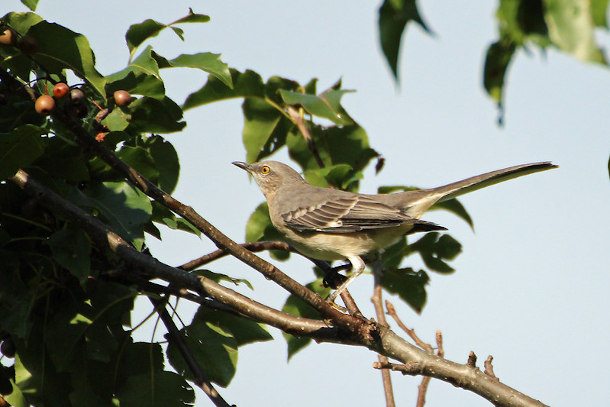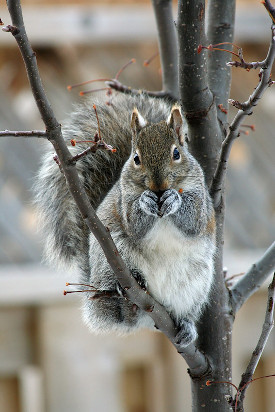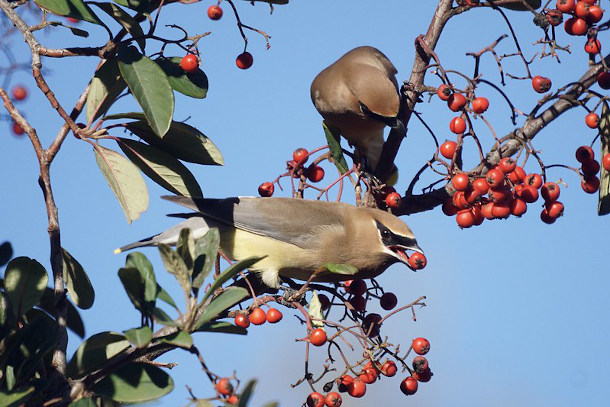The Pear Tree
Air Date: Week of May 29, 2020

A mockingbird eyes tiny fruit in a pear tree. (Photo: ptgbirdlover, Flickr CC BY 2.0)
Writer Jennifer Berry reflects on the wonders of a pear tree from her pre-pandemic life. Warblers, mockingbirds, and cedar waxwings are just a few of the creatures that find a feast in an old yet fruitful pear tree.
Transcript
CURWOOD: As the Covid-19 pandemic has emptied many office buildings once ordinary things can become fonder memories as writer Jennifer Berry of Sacramento, California reminds us.
BERRY: In the time before the virus, the view from my office looked upon an old, neglected pear tree I’d found disappointing. Snapped branches dangled like broken bones, blooms of mistletoe swelled in its canopy and water sprouts sprung upward like quills from every branch. I resigned myself to this meager connection to the natural world outside.

“Blooms of mistletoe swelled in its canopy.” (Photo: St. John’s College Cambridge, Flickr CC BY-NC-ND 2.0)
[MUSIC]
BERRY: Then one day a mockingbird came to visit. And every day after that. Over the months, I came to know this bird well — the cock of its head to eye something interesting, the precision with which it floats between branches, and its easy regard for other birds who stop by for a visit, unlike the scrub jays who chase everyone away.
[MUSIC]

A squirrel munches a tiny pear. (Photo: Perry Quan, Flickr CC BY-SA 2.0)
BERRY: Then winter came. And the tree, now bejeweled with tiny, bitter pears no bigger than olives, became this hallowed giver of life. The mockingbird plucked the fruit and swooped to the ground to peck it apart. The warblers preferred to peck the pears while they hung like piñatas. The crows moved in, took residence and one dive-bombed a squirrel that munched its way around the fruit as little flecks flew in every direction. But the squirrel simply ignored the assaults and turned its rear end toward the crow. Then the Cedar Waxwings came with their face masks and crests, and picked the tree clean.
[MUSIC]
BERRY: Then spring began to unfurl new life. Woodpeckers fish insects from the bark’s fissures, the crows yank at twigs for their nests and the bees hum over the welcoming blossoms. I wonder what comes next?
[MUSIC]
BERRY: But I work at home now, like so many others, rooted to our homes. I miss the pear tree and the rich life it supports.

“The Cedar Waxwings came with their facemasks and crests, and picked the tree clean.” (Photo: Mike’s Birds, Flickr CC BY-SA 2.0)
[MUSIC]
BERRY: Today, a goldfinch perched in the cover of my passion fruit vine outside my window at home and it took me back to that same feeling inspired by the pear tree, that we are never alone.
[MUSIC]
BERRY: And for now, maybe that’s all I really need.
CURWOOD: That’s writer Jennifer Berry with --“The Pear Tree”
Links
Living on Earth wants to hear from you!
Living on Earth
62 Calef Highway, Suite 212
Lee, NH 03861
Telephone: 617-287-4121
E-mail: comments@loe.org
Newsletter [Click here]
Donate to Living on Earth!
Living on Earth is an independent media program and relies entirely on contributions from listeners and institutions supporting public service. Please donate now to preserve an independent environmental voice.
NewsletterLiving on Earth offers a weekly delivery of the show's rundown to your mailbox. Sign up for our newsletter today!
 Sailors For The Sea: Be the change you want to sea.
Sailors For The Sea: Be the change you want to sea.
 The Grantham Foundation for the Protection of the Environment: Committed to protecting and improving the health of the global environment.
The Grantham Foundation for the Protection of the Environment: Committed to protecting and improving the health of the global environment.
 Contribute to Living on Earth and receive, as our gift to you, an archival print of one of Mark Seth Lender's extraordinary wildlife photographs. Follow the link to see Mark's current collection of photographs.
Contribute to Living on Earth and receive, as our gift to you, an archival print of one of Mark Seth Lender's extraordinary wildlife photographs. Follow the link to see Mark's current collection of photographs.
 Buy a signed copy of Mark Seth Lender's book Smeagull the Seagull & support Living on Earth
Buy a signed copy of Mark Seth Lender's book Smeagull the Seagull & support Living on Earth

